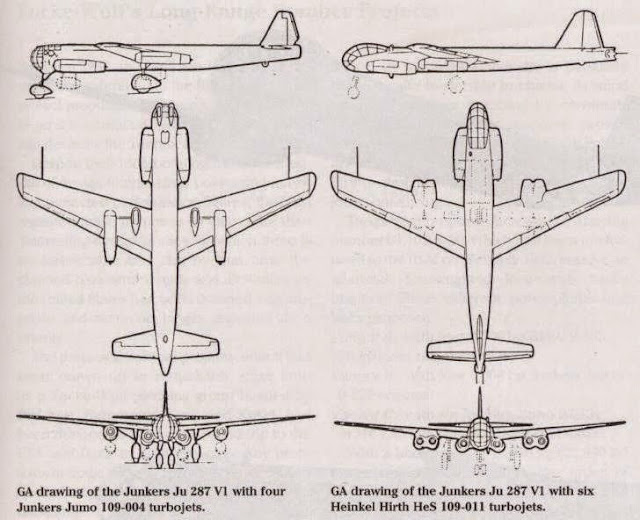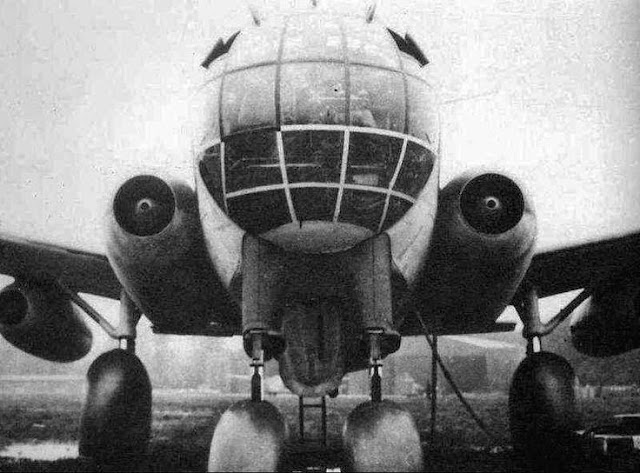A Revolutionary Jet Bomber
 |
| Junkers Ju 287. |
Work began in 1943. There were three prototypes under assembly before the war ended, and only the first one flew for the Germans. The task was to develop a fast bomber that could, for instance, hit the invasion beaches without fear of fighter interception. Head designer Dr. Hans Wocke proposed the revolutionary forward-swept wing shape in order to solve certain stability problems, such as placement of the bomb load in a single location and to provide extra lift at slow airspeeds present at landing and takeoff. The concept was under consideration in Russia and the United States, but only in Germany was it considered for jet aircraft.
The first prototype flew on 16 August 1944. It was assembled from spare parts of other aircraft such as the Heinkel 177 simply to test the aerodynamics. It had four jet engines, perhaps the first plane to have four. The craft flew well for the most part, but test pilot Siegfried Holzbaur noticed too much wing warping. By this time, the Luftwaffe High Command (Reichsluftfahrtministerium or "RLM") had given absolute priority to jet fighter designs, so all bomber projects were canceled. However, as was often the case in the Third Reich, the factory continued working on the project anyway.
The first (V1) prototype continued on 17 test flights without crashing, but they all must have been at slow speed. The test pilot found the plane to be very maneuverable. In light of the failures of other cutting edge projects, that was not a bad introduction, and the flights enabled some sorting out of jet engine issues and the like. Ultimately, though, testing was shelved until March 1945, when work suddenly resumed for some reason.
At this point the next two prototypes, which were in the form of the actual design rather than just makeshift parts, neared completion. It was, however, all a dead end, because post-war tests showed that the materials in existence could not have supported the spars at jet engine speeds. It was a straightforward matter of mass versus strength, and the materials at the time simply were not strong enough.
 |
| Three views of the Junkers Ju 287. The main problem was that the wings were swept too far forward for the materials at hand to support. A much smaller sweep might have worked. |
The RLM finally had seen the true revolutionary qualities of the jet class of warplanes, but it was far too late, and in any event, this was the wrong design. The war ended the following month with only one of the two remaining prototypes at 80% completion and the other just begun. The Soviets captured the prototype planes at Leipzig in Czechoslovakia and took them back to study, along with Dr. Wocke and his staff, but little came of it (perhaps because the German designers were not enthusiastic communists and did not have their hearts in it, or because of the materials problem). Dr. Wocke was allowed to return to East Germany in 1954, thence escaping to West Germany. He continued his development of the forward-swept wing concept and produced numerous slow-speed variants that flew well for businessmen. Even he, though, could not have made a high-speed jet work without the necessary materials.
 |
| The Ju 287 has an uncanny resemblance at this angle to much later bombers with multiple jet engines. It may not have been able to fly at high speeds, but it was beautiful. |
 |
| The V-2 prototype nearing completion. |
Well, you look at that crazy bomber and immediately think, "Those stupid Germans, no wonder they lost the war, wasting their time on fool's errands like that!"
In answer to that statement, well, maybe yes, maybe no. Certainly, the Ju-287 did not help the Germans to stave off defeat. They wasted a lot of time and effort on its development, just as they did on many other advanced designs.
As usual for those who read my blog, there is a 'the rest of the story' to this tale.
Only with the development of composite materials of great strength thirty years after the war were the forward-swept wing-warping (aeroelastic bending) problems observed at high speeds during the very first German test flights overcome.
Also, new technologies enabled jets to be dynamically unstable but flown with heavy computer assistance. Since then, the Americans (with the Grumman X-29) and the Russians (the Sukhoi Su-47) have experimented with the concept, but development has not proceeded.
If the major powers in the 1980s and 1990s had required a highly agile fighter, the forward-swept wing design could have been finalized. They soon turned in other directions - we think.
 |
| The X-29, the heir of the Ju-287, a NASA demonstration aircraft of the 1990s. |
2019






No comments:
Post a Comment